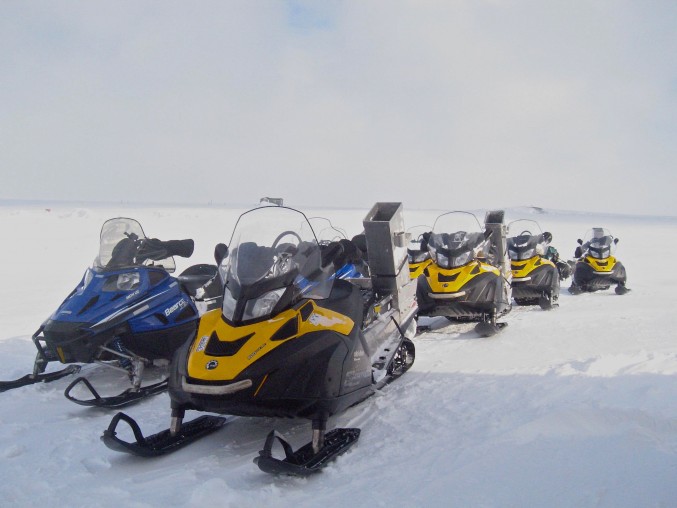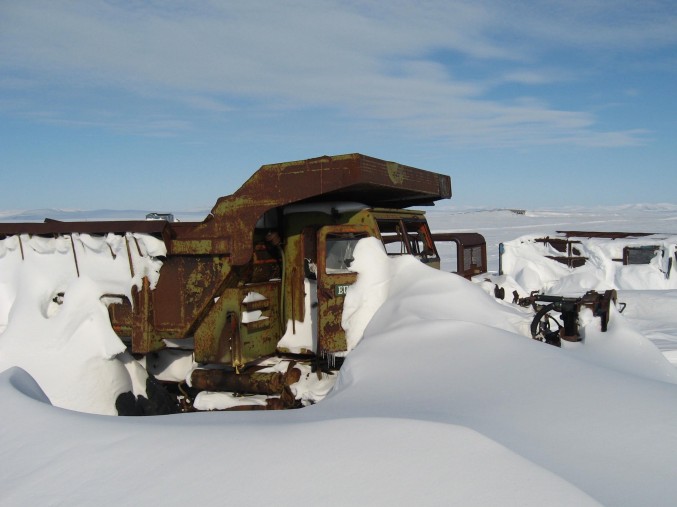There are many unique places on the Iditarod race trail. A spot that comes up daily in conversation as the mushers leave White Mountain and head to Nome is the Safety Road House. Back in the days when the dog team was the essential mode of transportation for supplies and people, road houses sprung up along trails a day’s travel apart. The Safety Road House is twenty two miles from Nome. When dog power ruled over horse power, twenty to twenty-five miles was considered a good day’s travel.
- Safety Road House 2006
- Safety Road House 2010
Between breakup and snowfall, tourists and residents of the area can head to Safety on the Nome – Council road. Once the road is closed for the winter, the quickest mode of transport is snowmachine. That’s exactly what I did yesterday, snowmachine out to Safety.
Iditarod’s Executive Director, Stan Hooley, extended an invitation to Iditarod™ Teacher on the Trail, Erin Montgomery and myself to make the trip with Donlin Gold race sponsors and Josie, the Nome City Manager. Meet behind the Mini at 13:00 with goggles, helmet and warm clothes. Warm clothes weren’t a problem but I had to scrounge around for the other safety gear. Thanks Jeff Schultz for lending me what I needed.
We got a quick (I won’t say crash) course on the operation of the machines – here’s the kill switch, here’s how to start it, here’s the switch for the hand warmers and throttle warmer and the brake is over here. We’d be running the wide track machines the trail crew uses to put out the lath that mark the trail.
By the way, Stan Hooley told us they put out 13,500 lath markers along the trail. The trail marker machines are set up with quivers so the guys can reach over their shoulder grab a piece of lath and stab it into the snow. After marking the trail for many years, they’ve got it down to an efficient science.
On the ride out we went around Cape Nome on the road then about 5 miles short of Safety, we stopped at Josie’s fish camp. We signed her guest book and stretched our legs. From there it was a quick ride to Safety. On the way back to Nome, we took the trail the mushers use which goes up and over Cape Nome. What a gorgeous, wide open view from the top.
Have you heard the story about how Nome was named? A cartographer made a note on a naval map “? Name” and then a person that read his notation thought he wrote “C. Nome.” Thus Nome become Nome. Over time there have been efforts to change Nome’s name to Anvil City, but it hasn’t happened.
- Welcome to Safety Road House
- Tom Allana
The Safety Road House is like no other place on earth. It’s only open during the summer months and briefly in March for the running of the Iditarod Trail Sled Dog Race. Every time I’ve been there, Tom Ellana is serving up beverages and cooking burgers for spectators that come out to see what Safety, the final checkpoint of the Iditarod, is all about. Snowmachine is by far the most common mode of transport out to the checkpoint in the winter but on this trip there was a helicopter and a snow cat that had also brought folks out. Tom is the fellow who hauls supplies out by snowmachine for the Iditarod. He opens up the place that’s stood vacant since fall, stokes the fire and waits on customers.
- Teacher on the Trail Dollar 2006
- Scale Model Race Car Over the Pool Table
The outside of the road house has been spruced up in the past ten years with a new face and a front porch. There are a couple of very old, very big, rusty snow covered trucks parked outside. There’s a long covered porch that shelters the door. The arctic entry serves it’s purpose during March, that’s for sure. Stepping inside, quests find themselves in a huge room furnished with a couch, a wooden cable spool that serves as a low table, a pool table with a scale model NASCAR suspended over head and not one but two wood stoves. The inside has oodles of memorabilia from its colorful history including a series of pictures of the building. Dollar bills that have been signed by visitors and stapled to the walls, ceiling, door frames and window trim give the common room a very interesting sort of shaggy appearance. Food and beverages are served up at the “U” shaped bar. A small kitchen is behind the bar. During the winter, the men’s room is closed with instructions to go make yellow snow. There’s a honey bucket in the ladies room.
The Iditarod communications equipment is set up right inside the door underneath a window so it’s easy to see outside and spot approaching mushers. Dropped dogs are lined out in the shelter of the old building. There aren’t food bags or large quantities of straw shipped out to Safety as very few mushers stop. There’s plenty of straw though for the dropped dogs and the few mushers wishing to revitalize.
I first visited the roadhouse in 2006 and did like thousands of others, signed a dollar bill and stapled it to the wall. Mine is just to the left of the entry. Then, not thinking, I forgot to take a picture. A couple years ago, I rode out there in a snow cat and actually found my dollar bill.
That’s the Safety Roadhouse Iditarod fans hear about continually as the mushers check into the last race checkpoint 22 miles from Nome. We watch the GPS tracker and figure that a fast time for the 22 miles from Safety to Nome would be 2.5 hours. Some mushers take it slow and make it in 3.5 hours but the common time is 3 hours, give or take a few minutes on either side. The Nome Kennel Club presents an award to the musher in the top twenty finishers who has the fastest time from Safety to Nome. For 2015, Wade Marrs made the run in 2 hours and 30 minutes. Nicolas Petit turned in a time of 2 hours and 31 minutes.










































